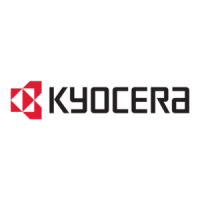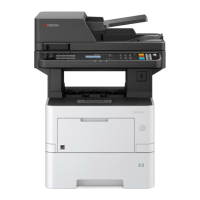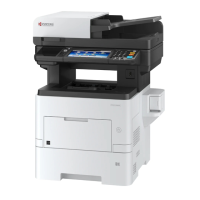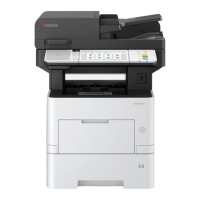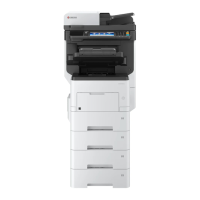
Do you have a question about the Kyocera ECOSYS M6235cidn and is the answer not in the manual?
| Copier resize | 25 - 400 % |
|---|---|
| Duplex copying mode | Auto |
| ID-card copy function | Yes |
| Maximum copy resolution | 600 x 600 DPI |
| Maximum number of copies | 999 copies |
| N-in-1 copy function (N=) | 2, 4 |
| Time to first copy (black, normal) | 7.5 s |
| Time to first copy (color, normal) | 8.5 s |
| Duplex copy speed (black, US Letter) | 35 ppm |
| Copy speed (color, normal, US Letter) | 35 cpm |
| Scan to | E-mail, FTP, SMB, TWAIN, USB, WIA |
| Scan drivers | TWAIN, WIA |
| Scanner type | Flatbed & ADF scanner |
| Grayscale levels | 256 |
| Scan speed (black) | 60 ppm |
| Scan speed (color) | 40 ppm |
| Image formats supported | JPEG, TIFF |
| Duplex scan speed (black) | 62 ppm |
| Duplex scan speed (color) | 46 ppm |
| Document formats supported | PDF, XPS |
| Printer fonts | Barcode, Bitmap, PCL, Windows |
| Printing colors | Black, Cyan, Magenta, Yellow |
| Duplex functions | Copy, Print, Scan |
| Maximum duty cycle | 100000 pages per month |
| Recommended duty cycle | 2000 - 8000 pages per month |
| Replacement cartridges | TK-5280K, TK-5280C, TK-5280M, TK-5280Y |
| Number of print cartridges | 4 |
| Page description languages | PCL 5c, PCL 6, PCL XL, PostScript 3, XPS |
| Faxing | No |
| N-up printing | 2, 4, 6, 8, 9, 16, 25 |
| Print technology | Laser |
| Resolution color | 1200 x 1200 DPI |
| Maximum resolution | 9600 x 600 DPI |
| Time to first page (black, normal) | 6 s |
| Duplex print speed (black, normal quality, A4/US Letter) | 17 ppm |
| Processor cores | 2 |
| Processor family | ARM Cortex-A9 |
| Coprocessor frequency | 0.1 GHz |
| Compatible memory cards | SD, SDHC |
| Maximum internal memory | 3000 MB |
| Sound pressure level (copying) | 52 dB |
| Sound pressure level (standby) | 30 dB |
| Sound pressure level (quiet mode) | 47 dB |
| Paper input type | Cassette, Paper tray |
| Total input capacity | 250 sheets |
| Maximum input capacity | 1850 sheets |
| Paper tray 2 input capacity | 500 sheets |
| Total number of input trays | 1 |
| Multi-Purpose tray input capacity | 100 sheets |
| Custom media width | 70 - 216 mm |
| Maximum print size | 216 x 356 mm |
| Custom media length | 148 - 356 mm |
| Paper tray media types | Plain paper |
| Paper tray media weight | 60 - 163 g/m² |
| Non-ISO print media sizes | Folio (media size), Legal (media size), Letter (media size) |
| ISO A-series sizes (A0...A9) | A4, A5, A6 |
| ISO B-series sizes (B0...B9) | B5, B6 |
| Multi-purpose tray media types | Bond paper, Envelopes, Labels, Legal, Letter, Letterhead, Plain paper, Recycled paper, Thick paper, Thin paper |
| Maximum ISO A-series paper size | A4 |
| Multi-Purpose Tray media weight | 60 - 220 g/m² |
| Auto Document Feeder (ADF) media weight | 50 - 120 g/m² |
| Display | TFT |
| Control type | Touch |
| Product color | Black, White |
| Display diagonal | 7 \ |
| Market positioning | Business |
| Email protocols | POP3, SMTP |
| Cabling technology | 10/100/1000Base-T(X) |
| Ethernet LAN data rates | 10, 100, 1000 Mbit/s |
| Mobile printing technologies | Google Cloud Print, Kyocera Mobile Print, Mopria Print Service |
| Standard interfaces | Ethernet, USB 2.0 |
| Optional connectivity | Ethernet, Wireless LAN |
| USB 2.0 ports quantity | 3 |
| AC input voltage | 220 - 240 V |
| AC input frequency | 50 - 60 Hz |
| Power consumption (max) | 1369 W |
| Power consumption (off) | 0.2 W |
| Power consumption (ready) | 84 W |
| Power consumption (sleep) | 0.6 W |
| Power consumption (copying) | 547 W |
| Power consumption (printing) | 532 W |
| Energy Star Typical Electricity Consumption (TEC) | 1.63 kWh/week |
| Mac operating systems supported | Mac OS X 10.10 Yosemite, Mac OS X 10.11 El Capitan, Mac OS X 10.12 Sierra, Mac OS X 10.13 High Sierra, Mac OS X 10.14 Mojave, Mac OS X 10.15 Catalina, Mac OS X 10.8 Mountain Lion, Mac OS X 10.9 Mavericks |
| Certification | TÜV/GS, CE |
| Cables included | AC |
| Included cartridge capacity (CMY) | 5000 pages |
| Included cartridge capacity (black) | 6000 pages |
| Operating altitude | 0 - 3500 m |
| Non-operating altitude | 0.6 - 15000 m |
| Storage temperature (T-T) | -20 - 40 °C |
| Operating temperature (T-T) | 10 - 32.5 °C |
| Storage relative humidity (H-H) | 10 - 90 % |
| Operating relative humidity (H-H) | 15 - 80 % |
| Sustainability certificates | Blue Angel, REACH, RoHS, EPEAT Silver, ENERGY STAR |
| Package depth | 623 mm |
| Package width | 726 mm |
| Package height | 828 mm |
| Package weight | 49000 g |
| Harmonized System (HS) code | 84433100 |
| Depth | 577 mm |
|---|---|
| Width | 480 mm |
| Height | 620 mm |
Provides safety warnings, symbols, environmental conditions, and precautions for machine use.
Explains laser radiation hazards and the machine's classification as a Class 1 laser product.
Details copyright, trade names, and registered trademarks of software and hardware components.
Describes Sleep, Auto Sleep, and Power Management functions for reducing energy consumption.
Identifies external and internal components of the machine, including the operation panel.
Guides for configuring wired and wireless network connections, including IPv4 and Wi-Fi settings.
Explains how to install necessary software, drivers, and utilities from the DVD for PC connectivity.
Details accessing and using the web-based interface for machine configuration and status monitoring.
Provides instructions for loading paper into cassettes and the multipurpose tray, including paper specifications.
Guides on setting up a shared folder on a PC and configuring network settings for document transfer.
Explains how to add and manage destinations for email, folders (SMB/FTP), and FAX in the address book.
Details the process of printing documents from a PC using the KX DRIVER and print settings.
Explains the various tabs and settings within the printer driver for print job configuration.
Describes how to store and print jobs from the machine's Job Box, Private Print Box, and Quick Copy Box.
Explains how to monitor printer status, view job progress, and check supplies via the Status Monitor.
Provides instructions for placing originals on the platen and in the document processor.
Details the basic operation for making copies, including placing originals and selecting functions.
Explains how to send scanned images via email, to folders (SMB/FTP), or using WIA/TWAIN.
Introduces the Document Box feature and its component boxes for storing and managing data.
Explains how to store scanned documents onto a USB memory device for later retrieval.
Lists and describes various functions like Copy, Send, Custom Box, and Removable Memory.
Guides on selecting the paper source (cassette, multipurpose tray) and matching paper size and type.
Details how to produce two-sided copies from one-sided or two-sided originals with binding options.
Allows specifying the image file format, quality level, encryption, and PDF/A settings for scanned documents.
Describes how to check the status of jobs being processed or waiting for printing.
Explains how to view the history of completed jobs, including print, send, and store logs.
Details procedures for pausing, resuming, or canceling jobs that are currently active.
Explains how to check the status of installed devices, network connections, and memory status.
Provides access to machine settings for overall operation, including language and default screens.
Details the configuration of network settings, including wired, wireless, and Wi-Fi Direct connections.
Explains settings for date, time, energy saving modes, sleep functions, and power management.
Covers procedures for adjusting print quality, such as color registration, drum refresh, and calibration.
Explains user access administration, security levels, and managing job accounts from a PC.
Details how to enable user login administration and select local or network authentication methods.
Explains how job accounting manages counts for copy, print, scan, and fax operations by account ID.
Details settings for default job accounting behavior, counter limits, and printing accounting reports.
Provides guidelines and corrective actions for common machine problems and error messages.
Explains how to respond to various messages displayed on the touch panel or computer.
Provides step-by-step instructions for removing paper jams from different machine locations.
Explains the procedure for clearing a staple jam from the optional manual stapler.
Lists and describes optional hardware and software components like memory, network kits, and staplers.
Provides specifications and guidelines for selecting and using various types of paper, including special paper.
Details the technical specifications of the machine's hardware components, copy, printer, and scanner functions.
Defines technical terms and concepts used throughout the operation guide for better understanding.

